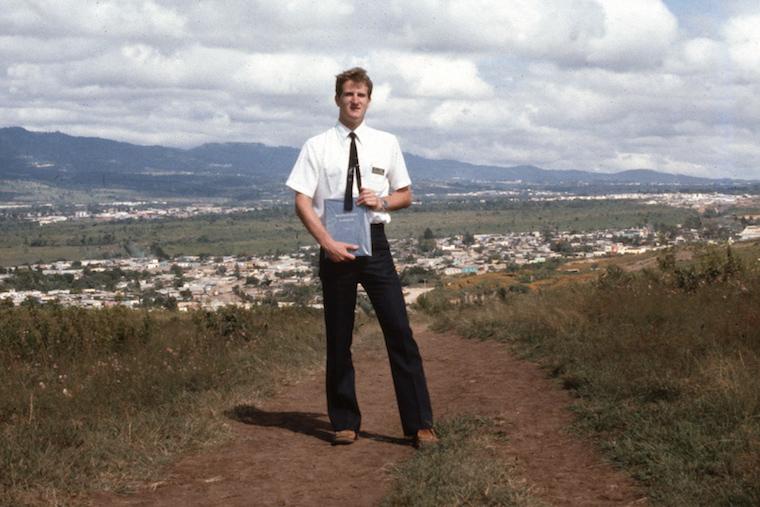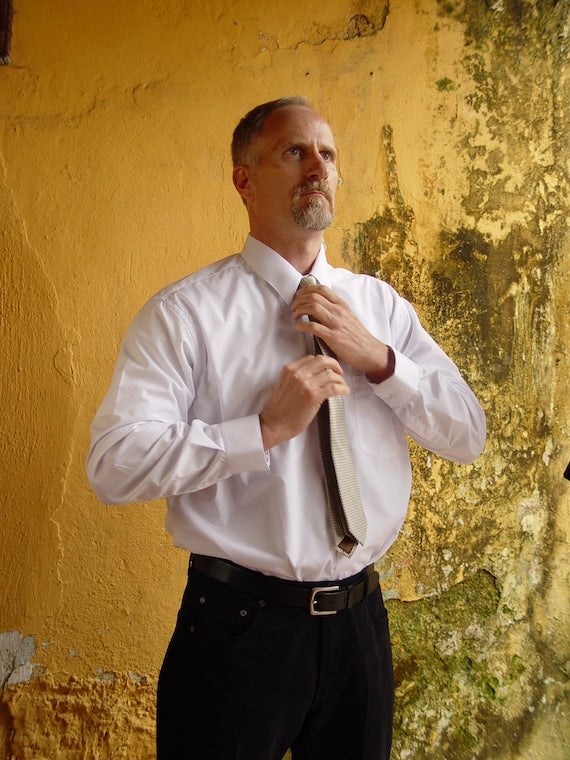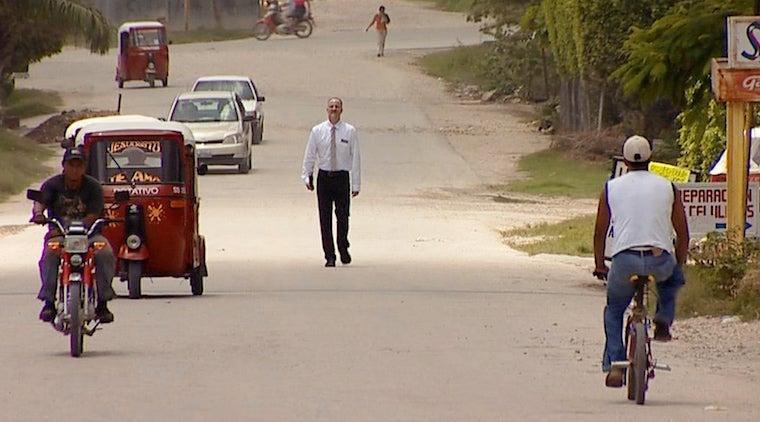A Conversation with Geoff Pingree, Professor of Cinema Studies and English
December 17, 2019
Amanda Nagy

Cinema Studies Professor Geoff Pingree is seen as a 19-year-old Mormon missionary in this still image from his documentary.
Photo credit: Courtesy of Geoff Pingree
The Return of Elder Pingree—Memoir of a Departed Mormon is the third major film project by Professor of Cinema Studies and English Geoff Pingree. For years, he avoided telling his deeply personal story.
Geoff Pingree recently released an autobiographical documentary, The Return of Elder Pingree—Memoir of a Departed Mormon. The film will be screened both Friday and Saturday evening during Commencement/Reunion Weekend.
Pingree retraces the steps he took 25 years earlier in Guatemala as devout missionary “Elder Pingree.” Combining archival material and contemporary footage as it moves from jungle village to the capital city, The Return of Elder Pingree pairs the young Elder Pingree's earlier, single-minded journey with the older Geoff Pingree's ambivalent return to Guatemala now as he seeks to discover what has become of the Guatemalans who once trusted him with their religious faith, attempts to understand the violent and unsettling political conditions of which he was ignorant as a regimented missionary, and grapples with the basic human dilemma of how one might do good in the world.
Pingree discusses the path that led him to documentary filmmaking, and why his latest project took 15 years to complete.
When did you begin teaching at Oberlin?
I began teaching at Oberlin in 2001. Prior to coming to Oberlin, I’d been teaching in Washington, D.C., for four years at both George Washington University and Catholic Universities of America.
As the title of your latest documentary suggests, you were raised in the Mormon faith, and you received your bachelor’s at Brigham Young University. What were your aspirations as an undergrad?
I attended BYU with a scholarship. I was always good at science and math, and when I began college, I wanted to be a surgeon. I was pre-med for my first two or three years.
Between my first and second year I went on my two-year mission in Guatemala, and once I returned to the U.S., something had shifted. I continued in the pre-med track briefly, but at some point I became disenchanted with solving problems that had clear, black-and-white answers, and I became more interested in complex, human-shaped problems.
I settled into the English major and began to consider becoming a professor. By the time I graduated from BYU, my relationship to the church was changing. I was in a very different place from where I’d started.
When did you begin laying the groundwork for The Return of Elder Pingree?
In 2004, I began work on a different feature documentary film. After a fair amount of research and pre-production work, just as I began shooting this film in the summer of 2004, one of the primary (and necessary) subjects decided to drop out, effectively shutting down the whole project.
Months earlier I had enrolled in a week-long documentary master class in the Media Workshops in Rockport, Maine, that was to begin that September, just a few weeks down the road. The workshop required each participant to arrive with a fully developed project.
The project that I’d planned to take was the film that was now dead in the water. I couldn’t recover any of my enrollment expenses, and my trip to Rockport was already planned, but now I had no film project.
This is where The Return of Elder Pingree comes into the picture.
Nearly 25 years had passed since my mission, but within a few years of my return from Guatemala, I was no longer a practicing Mormon. But over the years, I’d often thought about my experience in Guatemala because it felt tremendously important while I was there, and I sometimes wondered what it meant in the larger arc and context of my life.
A couple of years prior, I had a conversation with Lisa Abend (formerly a history professor at Oberlin, now a writer living in Copenhagen) about my mission, and she encouraged me to consider telling the story of my mission—and of what came after—in a film. So I’d been thinking about this for a couple of years, but each time I thought about actually moving forward on it as a film, I reminded myself that it would be worth the sacrifice only if I told the story unfiltered, with complete honesty. I am by nature quite shy, and I guard my privacy, so whenever I thought about making this film, I’d stop once I remembered what I’d have to give up to do it.
But when the film project I’d planned to take to the workshop in Maine fell through, I realized that if I wanted to go with a project in hand, I had no choice but to accelerate the film I’d kind of been avoiding for a few years.
While I was a missionary, phone calls to family and friends were not allowed (all correspondence had to take place via snail mail), and during my two years in Guatemala I had been archival in my habits of writing letters and journals, recording audio tapes, and taking 35 mm photographs. So I had all of those materials, as well as my ongoing internal conversation with myself about what I believed and about my relationship with my family and with the church.
I quickly pulled together materials, drafted a treatment, and—with deeply mixed feelings—headed to Maine. When I presented the project to other filmmakers in the master class, their response was extremely positive. This marked a turning point for me, and what had been mere private speculation now took life as a real film.
Now, 15 years later, the film is finally finished, and although I am uncomfortable every single time I watch or talk about it, I take some comfort from knowing that I did my best to be honest and open in making it.

How did you get on the path to documentary filmmaking?
From a very young age I was fascinated by recording devices (tape recorders, film cameras, movie cameras). I was very fortunate to have a family that could provide that for me, so by the time I was 12 years old I had a film camera, a Super 8 camera, and projector, which I put to use remaking Hollywood films starring family members, friends, neighbors, and our dogs (I’m pretty sure that anyone who participated in those films then would today not want to admit that they starred in them).
I enrolled in a graduate program in literature at the University of Chicago, thinking I might become a professor. The Spanish Civil War, which lasted from 1936 to 1939, was relevant to many of the public intellectuals I was reading, so somewhat on a lark, I took a trip to Spain, where I spent a few weeks poking around different archives. When I stopped at the Filmoteca outside Madrid (Spain’s national film archive), I met Alfonso del Amo García, who was leading an effort to identify and catalogue a large collection of films that had been made during and in response to the Spanish Civil War but that had also been hidden away in warehouses during Franco’s nearly 40-year reign. My dissertation explored the documentary cinema of that war.
In the early nineties, documentary film was just beginning to take off. Outside of festivals, the only non-fiction films that screened were by Ken Burns on PBS or Michael Moore at the cineplex.
It was not common for job candidates to teach both the critical study of cinema and filmmaking itself (several of my professors warned me away from this), but that’s basically how I constructed my career. In my graduate studies, film had become somewhat abstract, and I wanted to bring the practice of making films back into my work.
While I was finishing my dissertation, I enrolled in a graduate program in documentary filmmaking at George Washington University and began an internship at PBS.
Shortly after this, I took a job doing archival research for Nina Seavey’s feature-length documentary, A Paralyzing Fear: The Story of Polio in America. For a year I worked in a rented space in an office building in Takoma Park, in the northwest of Washington, using a fleet of Steenbecks and Moviolas to examine and assess hundreds of old 16mm and 35mm films, including a collection of films at the March of Dimes (the March of Dimes was a non-profit started by FDR and his law partner to raise money to combat polio), which hadn’t granted access to any outside researchers or filmmakers. We drove a huge freight truck up to New Jersey and loaded the films into the back. That proved to be a great opportunity in a number of ways: after the film was released and aired on PBS, to my great surprise I was nominated for and received an Emmy for archival research.
Soon after this, I was hired by Catholic University to build a media studies program, and I worked there for four years, during the day, while I taught documentary filmmaking at night at George Washington University. In 2001, Oberlin had decided to create a film major and program, and I was hired as part of that.
During my first several years at Oberlin, I was working toward tenure, and to do that I published mostly scholarly work. After I was tenured, I turned my attention towards more public work, which included several years working as a journalist in Spain, taking photographs for various news publications, and producing documentary films. This kind of documentary work has since remained my focus.
I’ve finished three major documentary projects while at Oberlin.
Two of them—Blue Desert, a film and multi-channel video installation shot during an expedition to Antarctica, and The Foreigner’s Home, about the intellectual and artistic vision of Toni Morrison—I created with Rian Brown, my colleague in Cinema Studies.
The third major film project, which I began before the other two and finished after them, is The Return of Elder Pingree—Memoir of a Departed Mormon.
I’ve also produced a series of short documentary films about urgent issues in northeast Ohio through StoryLens (storylens.org), a non-profit organization that I started with Rian and that I currently direct.
I am also currently finishing a feature-length fictional screenplay.

What was your overarching motivation for making The Return of Elder Pingree? What were some questions you hoped to answer?
My family comes from Mormon pioneers many generations back. It is a very large, close-knit, and prominent family in the Mormon community, so deciding to no longer practice, to leave the fold, was a consequential decision. Because of the closeness of my family, and because Mormons believe that family relationships are central and eternal, my departure from the church was a real disruption to my family. For many Mormons, to leave the church is to leave one’s family. My family is extraordinarily accepting and tolerant, and they have always supported me (they are the film’s biggest supporters). Still, my decision to leave the church has been difficult for my family in many ways.
What stands behind the making of the film, what stands behind the questions I was pursuing, is my relationship with my family. In many ways, my love and respect for my family provided a key motivation for me to struggle through this project and to try to figure things out. And I can’t help but think that my relationship with the people I loved and converted in Guatemala, the people who appear in the film, was a proxy for my relationship with my own family.
There are so many questions: Why was I no longer a practicing Mormon? Why did I leave the church? What does the mission mean now? What does my relationship with those people mean now that I no longer believe? As a missionary, my relationship with them was forged through their joining the church—friendship and shared belief were tangled up together. Like many Mormon missionaries, I occupied a nearly heroic role in their narratives of salvation. (As a nineteen year-old, this mostly flattered me, but in the years since, it has made me increasingly uncomfortable.) So I wasn’t sure if my friendship with them would survive my leaving the church, and I think part of me was afraid that this was true for my family as well.
Memory is malleable, and I don’t believe that it is—for any of us —completely reliable. I’m sure that the experience of making this film has affected and influenced the memories I have of my mission and of what happened after.
It wasn’t until I was talking face to face to the people I had been so close to during my mission that I started to wonder if they would still accept me, or if they would reject me.
I think that there is part of me that still hasn’t fully confronted my own family—will they accept me, or reject me? But making the film has brought me a little closer.
Are there any misconceptions about your background—or missionary work in general—that you set out to dispel?
There aren’t any misconceptions that I set out to dispel, but there are some that I hope to pre-empt. For example, I don't really think this film is about Mormonism. It’s a story whose main characters happen to be Mormons, but at its core is a struggle for self-knowledge and self-acceptance that is universal. The story takes place in a Mormon context, but I think that the experience of internal confusion, of feeling like an outsider in one’s own community, is familiar to a lot of people who are not Mormons.
Growing up, I felt like an outsider whether I was with Mormons (for harboring so many doubts) or with non-Mormons (for being a Mormon). I always knew that most people didn’t understand the religion I was raised in.
I have at times worried that people would see this film as an attack on the Mormon church, but if you look closely, that’s not the case. The film doesn’t take any theological position at all. It renders the experience of one individual trying to make sense of his doubts and beliefs.

Geoff Pingree
- Professor of Cinema and Media and English
- Director of Cinema and Media
- Co-Director, Apollo Outreach Initiative
- Co-Director, Apollo Center of Media Education and Production
- Faculty Advisor for the Journalism Integrative Concentration
You may also like…
Peter Takács—A Half-Century Celebrated
This spring marks the official conclusion of Takács’ tenure, after an incredible 48 years of teaching. Many of his former students from around the world are set to convene for a celebratory concert in Warner Concert Hall on May 12
Oberlin Presents Grammy-Winning Imani Winds in Concert
When flutist Brandon Patrick George ’08 attended Imani Winds’ Artist Recital Series performance back in 2007, he never imagined that he would one day sit in the flute chair. “Being able to perform...
David Byrd-Marrow Appointed Horn Faculty at Oberlin Conservatory
Versatile American horn player David Byrd-Marrow has been appointed to the tenure-track horn professor position at Oberlin Conservatory. He brings an expansive range of experience and repertoire to the role.


